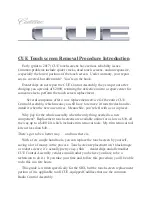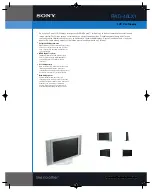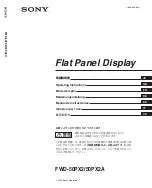
35
13. What is Flat Screen Plasma Technology?
Chapter 13 -What is Flat Screen Plasma Technology?
The flat panel plasma display is the latest display technology and offers the following TV / monitor features:
•
Bright screen light, easily viewable in any environment
•
High resolution for excellent image quality
•
Large, flat screen sizes
•
Wide viewing angle
•
Light weight
Flat screen plasma panels consist of cells that produce light. Three such cells of red, green and blue light form
a cluster known as a pixel. The brightness of the individual cell determines the color of the pixel. The number of
pixels on the screen is determined by the size of the screen. There are typically thousands of pixels on a screen
and there are three cells for each pixel.
Theory of Operation
Cell Operation
Each plasma cell functions much like a neon gas discharge tube or neon bulb. The bulb consists of two electrodes
in a tubular glass envelope filled with neon gas. When a voltage of approximately 65-70V (for a neon bulb) is
applied, the gas ionizes (resistance drops) and passes electricity. During ionization, an orange glow around the
negative (-) electrode is produced. Both electrodes appear to glow if AC is applied. Varying the current that is
allowed to flow (by changing the external series resistance) through the bulb controls the brightness.
Cell Structure
Refer to Figure 13-1 for the plasma cell structure. In a plasma cell, plasma replaces the neon gas in the tube.
Plasma is a collection of charged particles containing an equal number of + ions and electrons with properties
similar to gas, except they are conductive and affected by magnetic fields. When the Scan and Sustain electrode
(mounted on the glass faceplate) voltage reaches the electrical arc potential, the cell’s predominate neon and
xenon contents emit UV light. The UV light is converted to visible light by the red, green or blue phosphor of that
cell.
The data (also called index or address) electrode produces an induced electrical feedback signal to adjust cell
timing. The triad combination of one red, one green and one blue cell produces one pixel.
SUSTAIN ELECTRODE
(TRANSPARENT)
SCAN ELECTRODE
(TRANSPARENT)
FACE PLATE
ELECTRIC
LAYER
RIB
PHOSPHOR (GREEN)
PHOSPHOR (RED)
DATA ELECTRODE
PHOSPHOR
(BLUE)
PROTECTION
LAYER
FIGURE 13-1 - PLASMA CELL STRUCTURE
BACK PLATE
4TVP13 1435
4/15/02
DISCHARGE
















































